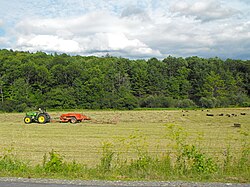Rural areas in the United States, often referred to as rural America,[1] consists of approximately 97% of the United States' land area. An estimated 60 million people, or one in five residents (17.9% of the total U.S. population), live in rural America. Definitions vary from different parts of the United States government as to what constitutes those areas.


Rural areas tend to be poorer and their populations are older than in other parts of the United States because of rural flight, declining infrastructure, and fewer economic prospects. The declining population also results in less access to services, such as high-quality medical and education systems.
Definitions
The United States Census Bureau defines these areas in the United States as sparsely populated and far from urban centers, which make up an estimated 3% of the land area of the U.S., but is home to more than 80% of the total population. The United States Office of Management and Budget defines rural areas in the United States by county; some rural areas are classified into metropolitan counties.[2][3] Others are spread throughout the numerous micropolitan statistical areas.[4]
The U.S. Department of Agriculture has four different systems for defining rural areas: Frontier and Remote (FAR) area codes, which define rural areas in four levels of increasing remoteness by ZIP code,[5] Rural–Urban Commuting Areas (RUCA), Urban Influence Codes (UICs), and Rural-Urban Continuum Codes (RUCC).[2][6]
The United States Department of Health and Human Services has two agencies that define rural areas. The Health Resources and Services Administration addresses the shortcomings of the U.S. Census Bureau, the U.S. Office of Management and Budget, and RUCA definitions to produce a definition that is balanced between them.[3] The Centers for Medicare & Medicaid Services uses its own definition for setting Medicare payment rates.[2]
CityLab defines rural areas by congressional district, based on census tracts and a machine-learning algorithm.[7][8]
History
Rural America was the center of the Populist movement of the United States in the 1880s and 1890s. Farmers tried to solve their problems using co-ops and the Grange movement. They failed to win elections and that movement ended in the Gilded Age.[9] The changes desired by farmers for economic stability in an era of rapid technological change in agriculture were put in place by government, as these ideas were sound.[9]
Since the 1940s and 1950s, the rural parts of the United States have largely been a stronghold for the Republican Party.[10][11]
A notable exception in recent years is Vermont. Despite being one of the most rural states in the nation, Vermont has a very heavy partisan lean in favor of the Democratic Party. It was Joe Biden's strongest state in the 2020 United States presidential election.
Demographics
Most rural counties are experiencing persistent population decline.[12]
Compared with households in urban areas, rural households had lower median household income ($52,386 compared with $54,296), lower median home values ($151,300 compared with $190,900), and lower monthly housing costs for households paying a mortgage ($1,271 compared with $1,561). A higher percentage owned their housing units "free and clear," with no mortgage or loan (44.0 percent compared with 32.3 percent).[13]

States with the highest median household incomes in rural areas were Connecticut ($93,382) and New Jersey ($92,972) (not statistically different from each other). The state with the lowest rural median household income was Mississippi ($40,200). Among rural areas, poverty rates varied from a low in Connecticut (4.6 percent) to a high in New Mexico (21.9 percent).[13]
About 13.4 million children under the age of 18 live in rural areas of the nation.[13]
Children in rural areas had lower rates of poverty than those in urban areas (18.9 percent compared with 22.3 percent), but more of them were uninsured (7.3 percent compared with 6.3 percent). A higher percentage of "own children" in rural areas lived in married-couple households (76.3 percent compared with 67.4 percent). ("Own children" includes never-married biological, step and adopted children of the couple).[13]
As of 2016, about 7 percent of homeless people in the United States live in rural areas, although some believe that this is an underestimate.[14]
Health
There are significant health disparities between urban and rural areas of the United States. The per capita rate of primary care physicians is lower in rural areas of the country (65 primary care physicians per 100,000 rural Americans, compared to 105 primary care physicians for urban and suburban Americans).[15] Rural Americans are also more likely than other Americans to suffer from chronic health conditions such as diabetes, heart disease, and cancer.[15]
A study published in the journal JAMA Pediatrics in 2015 analyzed data on U.S. youth suicide rates from 1996 to 2010. It found that the rates of suicides for rural Americans aged 10 to 24 was almost double the rate among their urban counterparts. This was attributed to social isolation, greater availability of guns, and difficulty accessing healthcare.[16]
Notwithstanding the economic and health challenges, a 2018 survey of rural adults found a majority felt they were better off financially than their parents at the same age. They thought their children would also experience such improvement. Forty percent said their lives came out better than they expected.[17]
See also
Notes
Further reading
- Duncan, Cynthia M. Worlds Apart: Poverty and Politics in Rural America (2d ed.: Yale University Press, 2014).
- Riney-Kehrberg, Pamela. ed. The Routledge History of Rural America (2018)